Mega-colonies
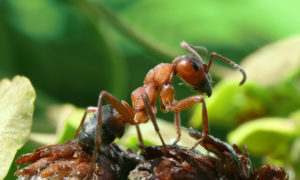
A version of this article was originally published in the December 2017 issue of BBC Wildlife Magazine
A subterranean city, a labyrinth of tunnels and chambers, home to some 300,000 inhabitants. At its centre, an aging queen surrounded by daughters; her protectors, foragers and nursemaids. Inside and out, plunderers and predators lurk. No, this isn’t Game of Thrones. It’s the reality of life for some of our most fascinating insects.
The wood ants are some of our most well-known insects. Take a walk in a good bit of woodland which is home to these animals and you’ll be hard-pressed to miss them. They’re often present in huge numbers and their nest mounds can be as much as 2m high. Looking closely at the mound and around your feet you’ll see thousands of scuttling ants, many of which have taken offence to your presence and are standing with jaws agape or spraying formic acid in your general direction, lending the air the distinctive odour of these insects.
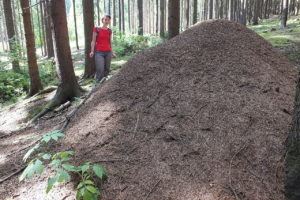
Covering the mound is a seemingly untidy thatch of pine needles and other plant material, but the thatch is actually constructed in such a way that it makes the most of the sun’s rays to warm the nest as well as protecting it from rain.
The loose thatch of the mound also belies the complexity of the nest beneath, which is nothing less than a marvel of arthropod architecture. The subterranean part is often bigger than the mound you can see above ground, giving you a good idea of the size of these structures. Shielded by the thatch is the rotting tree stump in which the nest was established, chambers for the queen, nurseries for the brood in varying stages of development – all the way from egg to pupa – not to mention food stores and rubbish tips.
Getting to grips with the structure of the nest and tracing its every tunnel and chamber is next to impossible without disturbing it in some way. Indeed, the challenges of working out what’s going on in one of these nests without upsetting it is one of the reasons why we still have so much to learn about wood ants. The internal architecture of the nest and the activity therein are one thing, but the over-arching social structure of these ants in the landscape is also remarkable (see Box).
Box
Super-colonies
The popular view of ant societies is a group of ants inhabiting a single nest ruled over by a single queen. Pain-staking research involving genetics and the marking of thousands of worker ants has shown the reality is much more complex. Wood ant colonies can have a single queen (monogyny) or lots of queens (polygyny) and the colony can inhabit a single nest mound (monodomy) or multiple, connected nest mounds (polydomy) that form by ‘budding’. In any given area there might be a mix of social structures; from one colony occupying one nest with a single queen to super-colonies occupying lots of separate but connected nests with hundreds of queens. At the most extreme end is a close relative of the southern wood ant from Japan (Formica yessensis) (IMAGE) that forms gigantic super-colonies, covering an area of 2.7 km2 and containing an estimated 306 million workers and 1 million queens. The budding strategy that forms super-colonies may be a relatively low risk way of expanding into new areas because the chances of a queen dispersing far from the colony and successfully establishing a new nest are very low.
The story of a nest can be acted out in a number of ways, but the beginning is always the same: young larvae in the darkness of a mature, healthy nest, destined to be queens, who are fed more, better quality food than the rest of the brood. Once adult, the young queens mate in the nest or exit the nest to mate nearby, either on the ground or in the air – the so-called nuptial flight.
Once mated they have to establish a nest and the place they often choose is a cosy retreat in a rotting tree stump, but the queens of many wood ant species are completely incapable of doing this on their own. A young southern wood ant queen becomes a parasite in the nest of a related ant species, relying on the host workers to do all the hard work for her. A queen that mates underground in her birth nest employs a different strategy and instead of turning parasite she establishes her nest very close to the birth nest with the help of a splinter group of workers. This process, known as ‘budding’, is the reason why in some populations of these ants you find a bunch of nests very close together forming a ‘super-colony’, whilst in other areas the nest mounds are more widely scattered (see Box). These ‘budded’ colonies retain links to the ‘mother’ colony and if they are too far from food sources they don’t make any foraging trails, instead relying on food from other parts of the super-colony’s empire. Some of these non-foraging nests may eventually form foraging trails and are then fully integrated into the super-colony, while others do not and are abandoned.
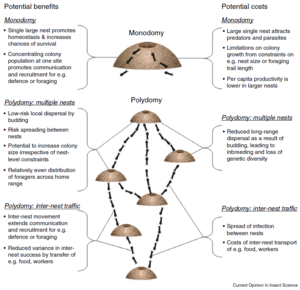
Establishing a nest depends on the queen being able to produce lots of daughters, who will maintain and expand the nest, tend to the brood, find food and repel enemies. Like all other ants, bees and wasps, this ability to produce an army of loyal daughters, hinges on the mind-bending nature of reproduction in these animals. The queen ant can control the sex of her offspring by using the sperm she stored from her single dalliance vary sparingly. If a daughter is needed the queen releases a tiny amount of sperm to fertilise the egg as it’s being laid. If the queen withholds the sperm the egg is not fertilised and it will develop into a son. This quirk is at the root of the success of ants because it means that a female worker is more closely related to her sisters than her own offspring, so it pays for her to look after her sisters and the nest rather than strike out on her own and have her own babies.
With a nest well a truly established, this sisterhood begin to exert a powerful influence on their habitat. The driving preoccupation of the multitude of ant workers in a nest is the sourcing of food for themselves and their nest-mates, including the brood, who are particularly ravenous. If you watch one of these nests, or one of the foraging trails leading to it, for any length of time you’ll see bits and pieces of various insects and spiders that have been butchered and are being transported back to the nest to be fed to the brood. Any arthropods are fair game. Any caterpillars, beetles or spiders that find themselves on the wrong side of a foraging party will be quickly subdued and dismembered. Although these ants are very capable predators and scavengers their most important food source, making up 90% of their diet, is the sweet liquid – honeydew – that oozes from the back-ends of aphids high in the canopy of the trees that surround the nest. An ant delicately strokes an aphid with its antennae to elicit a droplet of honeydew which it greedily consumes – a process known as ‘milking’. Like miniature herders tending their livestock, the ants are very protective of the aphids and will drive off the many species for whom aphids are a favourite snack. They’ll even move the aphids to better feeding grounds to increase the production of honeydew. Satisfied ants with bloated abdomens then head back to their nest and regurgitate the honeydew for the queen and other workers.

In tending and protecting aphids and eating leaf-munching insects, these ants have a considerable impact on tree growth and the structure of the forest. They also play a crucial role in nutrient cycling, taking honeydew and arthropod prey from the canopy/surrounding forest down into their subterranean chambers. These outside nutrients, all the waste material produced in the nest and the constant digging and tweaking of the nest helps to enrich the soil for further plant growth. In constructing their elaborate nest mounds the ants move lots of plant material, including seeds and they’ve been shown to be important seed dispersers for many plants, including some rarities, such as small cow-wheat (Melampyrum sylvaticum) (IMAGE). Even though the nest mound is protected by hordes of fierce, acid squirting workers, it is nothing more than a pile of food to many larger animals, such as badgers, capercaillies and green woodpeckers. To these animals, the brood deep in the nest are the real prize as they’re succulent and less bitey than the workers.
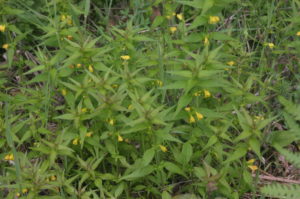
The internal complexity of the nest, its benign conditions and the bounty of food and protection it offers has also been a draw for a veritable menagerie of other animals, some of which are completely dependent on the ants. As an entomologist, it is this aspect of life inside the nest that really excites me as the biology of many of these ant-associates is shrouded in mystery. One-hundred and twenty-five arthropod species are known from in or around wood ant nests. There are 52 beetle species, 28 mite species, 15 species of other ants and wasps, ten fly species, eight true bugs, six spiders and even a moth. Some of these live in close proximity to the nest, others live in the nest, but are not tolerated if discovered and there are still more that fool the ants into accepting them. It is among the many beetle species where we see the most intriguing ant guests.
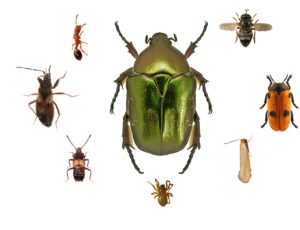
Take the rove beetle, Lomechusa pubicollis (IMAGE), which as a larva lives deep inside the nest of southern wood ants and dupes its hosts into grooming, feeding and carrying it by tapping into the odour-dominated messaging system of its hosts. In effect, the ants treat the beetle larva as one of their own brood. In return, the young beetle tucks into the developing siblings of its carers. After pupation, the adult rove beetles begs it carers for food one more time and heads out of the nest to seek out the nest of other ant species (mostly Myrmica sp.) in which to see out the winter. As the warmth of spring arrives the rove beetle slips back into another southern wood ant nest where it will breed to complete its lifecycle.
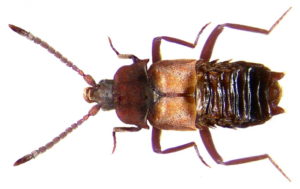
A strange leaf beetle (Clytra quadripunctata) (IMAGE) is another specialist in the nests of southern wood ants. From a leafy perch, the female Clytra deftly encases each of her eggs in faeces before flicking them to the ground. Some of these eggs are picked up and carried by workers into the nest. The beetle larvae hatch but retain their egg case as a mobile retreat, recoiling into it at the first sign of danger, their tough little head making a perfect plug. They add to the case with their own droppings and soil as they grow, eventually forming a perfect little pot (IMAGE). Trundling around the ant’s nest these larvae feed on organic matter and detritus in the nest and are impervious to attack thanks to their protective pots. This is not the case for the adult beetle when it emerges and it must run a gauntlet of angry worker ants to escape the nest. These exploiters of ants can often infest the nest mound in such large numbers that the hosts are forced to abandon it.
The case-bearing larva and the colourful adult of the fascinating leaf beetle, Clytra quadripunctata. The larvae of this species live only in the nest of the Formica rufa.
We still have a huge amount to learn about the inner workings of these very familiar ants and their interactions with other species. We know they are a crucial element of forests around the world and that they’re extremely vulnerable to human activities, which has caused the decline and extinction of some species. Only by studying them will we fully appreciate their ecological significance and fragility.
Further reading
Ellis S and Robinson EJH. The role of non-foraging nests in polydomous wood ant colonies. PLoS ONE 2015 10(10): e0138321. doi:10.1371/journal.pone.0138321.
Robinson EJH. Polydomy: the organisation and adaptive function of complex nest systems in ants. Current Opinion in Insect Science 2014;5:37–43.
Dekoninck W et al. Polygyny and strong genetic structuring within an isolated population of the wood ant Formica rufa. Journal of Hymenoptera Research 2014;41:95–111.
Parmentier T et al. A highly diverse microcosm in a hostile world: a review on the associates of red wood ants (Formica rufa group). Insectes Sociaux 2014;DOI 10.1007/s00040-014-0357-3.
Iakovlev IK et al. Trophic position and seasonal changes in the diet of the red wood ant Formica aquilonia as indicated by stable isotope analysis. Ecological Entomology 2017;DOI: 10.1111/een.12384.
Laakso J and Setala H. Impacts of wood ants (Formica aquilonia Yarr.) on the invertebrate food web of the boreal forest floor. Ann Zool Fennici 2000;37:93-100.
Neuvonen S et al. Stand type is more important than red wood ant abundance for the structure of ground-dwelling arthropod assemblages in managed boreal forests. Agricultural and Forest Entomology 2012;DOI: 10.1111/j.1461-9563.2012.00569.x.
BWARS website – Formica species http://www.bwars.com/category/taxonomic-hierarchy/ant/formicidae/formicinae/formica
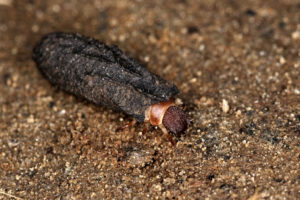
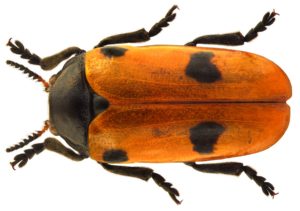
Leave a Reply